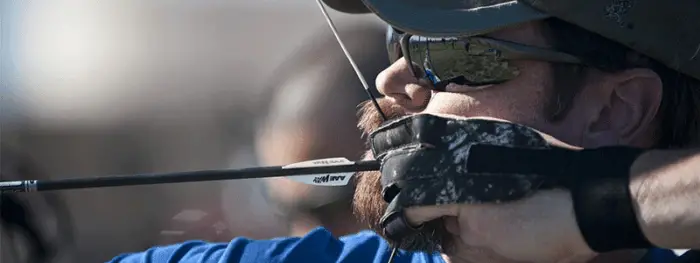Let off is one of the most important features of a compound bow. It’s what allows compound archers to use much higher draw weights with high precision. In this post, we’ll cover the topic of let off, how it came to exist, and more.
Let off is the percentage of the draw weight the archer holds on a fully drawn compound bow. A higher let-off means you hold less weight on a full draw, allowing you to aim comfortably even when using a high draw weight.
Let’s say, for example, you have a compound bow with a draw weight of 70 pounds, and let off of 75%. This means that when you pull the bow, through most of the way to full draw, you’ll pull 70 pounds. At full draw, 75% of the 70 pounds will be reduced, meaning you’ll only hold 17.5 pounds. This is huge.
A standard compound bow will have let off of between 60% to 90%. These are just a rule of thumb though, and it does vary between different models. Some bows even have a feature of a changeable let-off percentage.
But you’re probably wondering how let-off actually works on a compound bow. Let’s start by explaining the complex mechanics that are involved in achieving it.
How does let off work?
This might be somewhat of a hard topic to explain, but the mechanics of the bow are what’s creating the let-off. I’ll try to use simple terms and intuition as much a possible.
The way let off actually works is by the elliptical shape of the cams, which allow for more string to be pulled, and by the limbs of the bow being pulled closer. This creates a mechanical advantage, so the archer feels a lower weight.
The shape of the cams is designed to allow the right amount of string to be pulled when the archer gets close to the back wall. The cams rotate faster at that point.
The limbs coming together is really the magic piece here. This allows for more of the weight to be put on the limbs, instead of being put on the archer.
You can see how much force the archer need to exert to pull the bowstring in this famous graph:

So initially the archer doesn’t feel a lot of weight, but quickly the highest weight is achieved. At some point close to full draw, the weight curve shifts and it starts to decrease until let off is achieved. If the archer tries to pull the bow beyond this point, the poundage increases again (this is what’s known as “the wall”).
Here’s a youtube video I found that explains how let-off works really well. I recommend watching it if you’re interested in the physics aspect of the concept.
You don’t have to understand the physics behind this feature to understand this – the entire bow is designed to have the let off. It’s a major feature of the compound bow.
Does let off affect arrow speed?
In general, let-off does not affect the speed of your arrows, it only affects the draw weight behavior at full draw. The forces that push the arrow throughout its path, until it leaves the bow, are mostly the same for any let-off percentage.
The main reason for this is that most compound bows these days use hard cams. These cams, unlike soft cams, don’t speed the arrow up gradually.
This means that the let-off percentage, on most bows, only affects a short part of the arrow path close to the back wall. The difference in speed is typically less than 3 fps, which is tiny.
If you want to learn more about the different cam systems of compound bows, read my detailed post about single vs dual cam compound bows.
What is the best let off on a compound bow?
When I first heard about it, my first thought was “why shouldn’t I get a bow with let off as high as possible?”. I mean, having the hold a lot of weight isn’t a good thing, is it?
But a high let-off has a lot of negative consequences you should consider, like how clean your shot is, how able you are to engage your back muscles, and more.
As a general rule, target archers seem to find let-off of around 65% the best to use, while bowhunters typically use a higher let-off of around 75%. Higher let-off makes holding the drawn bow easier, but it also makes shooting clean shots harder.
Let’s discuss the advantages of using a high let-off bow:
- Easier to hold at full draw. With a higher let off you can hold your bow for longer and focus on aiming without being distracted. This can increase your accuracy.
Especially for bowhunters, who sometimes have to wait for long periods of time for a target to move, or change positions themselves, the extra time at full draw can be critical. - Easier to shoot for longer periods of time. Having less weight to hold can save you energy, so you can have longer training sessions without getting tired.
Unfortunately, there are also some disadvantages in using a high let-off bow:
- Clean shots are harder. By having a high let off, you’ll need to use much less force to keep the bow at full draw. This means that any small force you’ll exert by accident on the arrow will significantly affect its path, and change its direction. It’s actually a known fact that high let off bows are much harder to shoot with.
- Harder to keep back tension with. This is one of the essential parts of proper archery technique, which is much more difficult to achieve with higher let off. You need some force to engage your muscles, and having less weight at full draw will definitely make keeping your form much harder.
Read more about how to keep a correct archery form in my post about shooting posture. - Some countries and states limit the amount of let off you can have on your bow. This is kind of a technical fact, but should still be considered if you live in one of these states. Check your local regulations before getting your gear.
Overall, there’s no magic number every archer will find comfortable to use. There are pros and cons that should be considered, and every archer should think about the trade-off and make a decision based on their needs.
Conclusions
In this post, I’ve laid out what let off is on a compound bow, how it works, and how to find the right amount for you. Overall, it’s all a matter of preference, and of how you use your bow.
I hope this post helped you understand what let off is, and to make an informed decision on your own bow.
The Best Compound Bows I’ve Reviewed
Genesis Genx
A great budget option for beginner archers, who are looking for a great first bow at a reasonable price. This bow is perfect as an entry bow you can progress with, since you can adjust the draw weight between 25 lbs and 40 lbs, and the draw length between 21″ and 30″.
Like most other things, you can find it in Amazon.
Diamond Infinite Edge Pro
This is my absolute favorite recommendation to beginners, who are looking for a bow to start and progress with. This highly adjustable compound bow comes with an insane draw weight range of 5 pounds to 70 pounds, and draw length of 13″ to 31″.
You can also read more in the full compound bow buyer’s guide.






